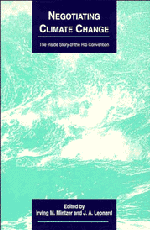Book contents
- Frontmatter
- Contents
- Acknowledgements
- Commonly Used Acronyms
- Foreword
- Part I Background
- Part II Views from Within the Ring
- 3 Exercising Common but Differentiated Responsibility
- 4 The Beginnings of an International Climate Law
- 5 Constructive Damage to the Status Quo
- 6 The Climate Change Negotiations
- 7 A Personal Assessment
- 8 The Road to Rio
- 9 A Failure of Presidential Leadership
- 10 Looking Back to See Forward
- Part III The Outside Edges In
- Part IV Prospects for the Future
- Appendix: The Framework Convention on Climate Change
- Index
8 - The Road to Rio
Published online by Cambridge University Press: 01 June 2011
- Frontmatter
- Contents
- Acknowledgements
- Commonly Used Acronyms
- Foreword
- Part I Background
- Part II Views from Within the Ring
- 3 Exercising Common but Differentiated Responsibility
- 4 The Beginnings of an International Climate Law
- 5 Constructive Damage to the Status Quo
- 6 The Climate Change Negotiations
- 7 A Personal Assessment
- 8 The Road to Rio
- 9 A Failure of Presidential Leadership
- 10 Looking Back to See Forward
- Part III The Outside Edges In
- Part IV Prospects for the Future
- Appendix: The Framework Convention on Climate Change
- Index
Summary
Prologue
Brazil's participation in the United Nations Conference on Environment and Development (UNCED, sometimes called the Earth Summit or Rio '92) began in 1988. Then-President Sarney responded to the outcry in the international press on the “burning of the Amazonia forest” by offering to host the Earth Summit. Until then, global environmental concerns had been absent from discussions in Brazil. Typically, the reports appearing in the international press of events occurring in the Amazonia were most often regarded in Brazil as attempts to interfere with national sovereignty.
Moreover, the environmental movement was not very strong in Brazil at this time. Urgent, more immediate problems—such as the very serious water and air pollution problems in the cities—were consuming the attention of the fledgling environmental movement. Their focus was on such cities as Cubatao, near the Port of Santos, which became popularly known as the “valley of death.”
It was the Montreal Protocol on Substances that Deplete the Ozone Layer that first raised awareness of global environmental problems in Brazil. Political leaders and private citizens began to recognize that serious global problems existed and that events taking place inside national borders could influence the climate in other countries.
- Type
- Chapter
- Information
- Negotiating Climate ChangeThe Inside Story of the Rio Convention, pp. 175 - 186Publisher: Cambridge University PressPrint publication year: 1994
- 5
- Cited by



